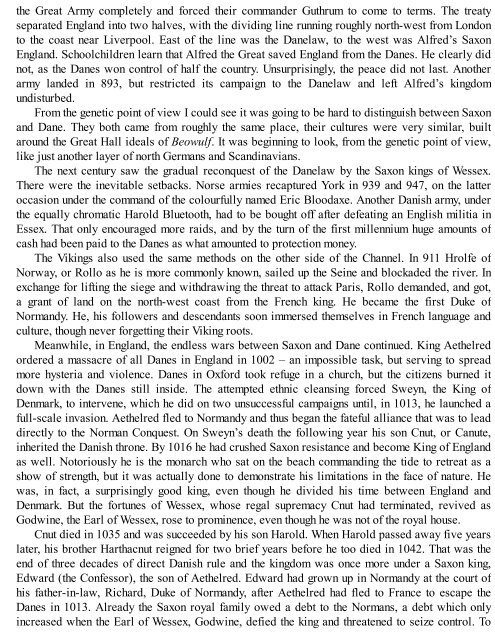Create successful ePaper yourself
Turn your PDF publications into a flip-book with our unique Google optimized e-Paper software.
the Great Army completely and forced their commander Guthrum to come to terms. The treaty<br />
separated England into two halves, with the dividing line running roughly north-west from London<br />
to the coast near Liverpool. East of the line was the Danelaw, to the west was Alfred’s Saxon<br />
England. Schoolchildren learn that Alfred the Great saved England from the Danes. He clearly did<br />
not, as the Danes won control of half the country. Unsurprisingly, the peace did not last. Another<br />
army landed in 893, but restricted its campaign to the Danelaw and left Alfred’s kingdom<br />
undisturbed.<br />
From the genetic point of view I could see it was going to be hard to distinguish between Saxon<br />
and Dane. They both came from roughly the same place, their cultures were very similar, built<br />
around the Great Hall ideals of Beowulf. It was beginning to look, from the genetic point of view,<br />
like just another layer of north Germans and Scandinavians.<br />
The next century saw the gradual reconquest of the Danelaw by the Saxon kings of Wessex.<br />
There were the inevitable setbacks. Norse armies recaptured York in 939 and 947, on the latter<br />
occasion under the command of the colourfully named Eric Bloodaxe. Another Danish army, under<br />
the equally chromatic Harold Bluetooth, had to be bought off after defeating an English militia in<br />
Essex. That only encouraged more raids, and by the turn of the first millennium huge amounts of<br />
cash had been paid to the Danes as what amounted to protection money.<br />
The Vikings also used the same methods on the other side of the Channel. In 911 Hrolfe of<br />
Norway, or Rollo as he is more commonly known, sailed up the Seine and blockaded the river. In<br />
exchange for lifting the siege and withdrawing the threat to attack Paris, Rollo demanded, and got,<br />
a grant of land on the north-west coast from the French king. He became the first Duke of<br />
Normandy. He, his followers and descendants soon immersed themselves in French language and<br />
culture, though never forgetting their Viking roots.<br />
Meanwhile, in England, the endless wars between Saxon and Dane continued. King Aethelred<br />
ordered a massacre of all Danes in England in 1002 – an impossible task, but serving to spread<br />
more hysteria and violence. Danes in Oxford took refuge in a church, but the citizens burned it<br />
down with the Danes still inside. The attempted ethnic cleansing forced Sweyn, the King of<br />
Denmark, to intervene, which he did on two unsuccessful campaigns until, in 1013, he launched a<br />
full-scale invasion. Aethelred fled to Normandy and thus began the fateful alliance that was to lead<br />
directly to the Norman Conquest. On Sweyn’s death the following year his son Cnut, or Canute,<br />
inherited the Danish throne. By 1016 he had crushed Saxon resistance and become King of England<br />
as well. Notoriously he is the monarch who sat on the beach commanding the tide to retreat as a<br />
show of strength, but it was actually done to demonstrate his limitations in the face of nature. He<br />
was, in fact, a surprisingly good king, even though he divided his time between England and<br />
Denmark. But the fortunes of Wessex, whose regal supremacy Cnut had terminated, revived as<br />
Godwine, the Earl of Wessex, rose to prominence, even though he was not of the royal house.<br />
Cnut died in 1035 and was succeeded by his son Harold. When Harold passed away five years<br />
later, his brother Harthacnut reigned for two brief years before he too died in 1042. That was the<br />
end of three decades of direct Danish rule and the kingdom was once more under a Saxon king,<br />
Edward (the Confessor), the son of Aethelred. Edward had grown up in Normandy at the court of<br />
his father-in-law, Richard, Duke of Normandy, after Aethelred had fled to France to escape the<br />
Danes in 1013. Already the Saxon royal family owed a debt to the Normans, a debt which only<br />
increased when the Earl of Wessex, Godwine, defied the king and threatened to seize control. To
















